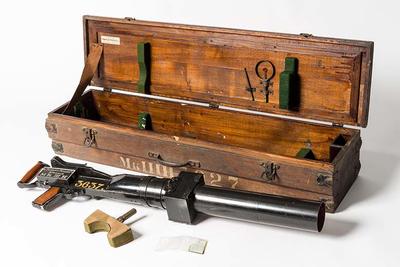Aerial Camera - Mk III Hythe
Production date
1914-1915
Country
England
See full details
Object detail
Description
MkIII Hythe Gun aircraft camera #3637, in case for 3027 model. Gun modelled on Lewis aerial machine gun, but with lens and film spool canister to take roll film. The lever on the side of the gun advances the film to the correct position and to take a shot, the trigger is pulled.
Crate is wooden with metal hinges, latches and handle. Inside the gun camera supports are covered with green felt, some of which is peeling/worn. A small draw inside a compartment at one end of the box has a revolving brass hinge to secure it. A heavy, coarsely woven band of material connects the lid and base of the case at one end.
Crate is wooden with metal hinges, latches and handle. Inside the gun camera supports are covered with green felt, some of which is peeling/worn. A small draw inside a compartment at one end of the box has a revolving brass hinge to secure it. A heavy, coarsely woven band of material connects the lid and base of the case at one end.
Classification
PHOTOGRAPHY Cameras Still thornton pickard
Maker
Production date
1914-1915
Production place
Measurements
Camera: L970 x W110 x H205 mm
Case: L1055 x W300 x H175 mm
Case: L1055 x W300 x H175 mm
Media/Materials description
Steel, wood, brass, felt, glass.
Signature/Marks
THORNTON-PICKARD \ ALTRINGHAM \ MK.III.H
3637.
INSPECTOR (P) \ R.A.F \ 2
MIIIH 3 0 2 7
MADE BY \ THORNTON-PICKARD CO., LTD., \ ALTRINGHAM. ENGLAND.
3637.
INSPECTOR (P) \ R.A.F \ 2
MIIIH 3 0 2 7
MADE BY \ THORNTON-PICKARD CO., LTD., \ ALTRINGHAM. ENGLAND.
History and use
Manufactured in 1915 by Thornton Pickard, the Hythe Mark III Aerial Camera was named after the Royal Air Corps Gunnery School in Hythe, Kent, and designed to look and feel like a Lewis machine gun, one of the most common machine guns fitted to combat aircraft at that time.
In the early days of World War 1, as the Royal Air Force was coming into its own, it became apparent that some form of training was needed in the use of ordnance to be used in aerial combat, or “dog fights”. Very similar in weight and appearance to an actual Lewis gun, the Hythe Ariel Camera was developed to address this need.
The camera was fitted to the plane in a similar position and method to the actual gun, and was and operated in much the same way. The trigger mechanism worked the camera’s shutter while the film was advanced using the “gun’s” charging handle. The crosshairs of the sighting apparatus were reproduced on the developed film, thereby recording a “hit or miss”
After the end of the War, these cameras became commercially available, and were still being used by the Royal Air Force up to the early stages of World War 2, when they were replaced by the Williamson camera gun.
This camera was donated to the Queensland Museum by Mr Fred Port, a freelance photographer and WW1 veteran, and makes up part of the Port Photographic Collection.
In the early days of World War 1, as the Royal Air Force was coming into its own, it became apparent that some form of training was needed in the use of ordnance to be used in aerial combat, or “dog fights”. Very similar in weight and appearance to an actual Lewis gun, the Hythe Ariel Camera was developed to address this need.
The camera was fitted to the plane in a similar position and method to the actual gun, and was and operated in much the same way. The trigger mechanism worked the camera’s shutter while the film was advanced using the “gun’s” charging handle. The crosshairs of the sighting apparatus were reproduced on the developed film, thereby recording a “hit or miss”
After the end of the War, these cameras became commercially available, and were still being used by the Royal Air Force up to the early stages of World War 2, when they were replaced by the Williamson camera gun.
This camera was donated to the Queensland Museum by Mr Fred Port, a freelance photographer and WW1 veteran, and makes up part of the Port Photographic Collection.
Associated person
Registration number
H905



